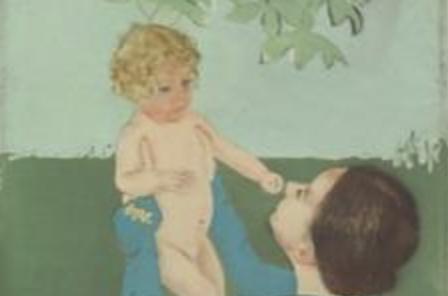The word ‘Labor’ in the title of the companion exhibits that open the new year for the Academy Art Museum (AAM) takes on very different meanings upon viewing. Although there are no depictions of women delivering babies in any of the etchings or paintings that make up the slender but charming Mary Cassatt exhibit in AAM’s Lederer Gallery, there are plenty of mother and child together.
Across the hall, in the Healy Gallery, the “Labor and Leisure” show drawn from the museum’s permanent collection is long on images of men at work. Of course, there’s nothing wrong with the 1945 watercolor of a shirtless man powering a “Drill,” the title of a Robert Riggs print.
Taken together, the two exhibits have little to do with each other except that they are mostly of prints, etchings, and engravings with scattered oils or watercolors here and there. Plus, in the case of Robert Rauschenberg’s conspicuous, if enigmatically titled, 1986-87 “Tibetan Garden Song,” there is a cello bathed by scrub brush in a gleaming metal tub. Who knows – I don’t – what to make of it? But it’s really cool.
Cool is not the word that comes to mind while taking in Cassatt’s prints and paintings in this interpretation of “Labor and Leisure.” Her images are warm and reflective of a life observed but not experienced first-hand. She never bore nor raised children of her own. Several of her models are children of her siblings, in many cases described in titles you can discern without reading them, such as the loveliest oil painting in the exhibit, “Mother Resting Her Cheek on Her Daughter’s Blond Hair,” from 1913. Apparently unrelated to her is a little girl and her mom in a preparatory sketch for Cassatt’s 1893 painting “The Child’s Bath,” seen in a drypoint drawing resulting from her study of Japanese printmaking.
From a period in her career largely realized in Paris with the help of her mentor Edgar Degas, are two images depicting leisure-time diversions: Cassatt’s delicate multi-plate color etching “The Banjo Lesson” and her tender aquatint print of mother and daughter in the shade “Under the Horse-Chestnut Tree.” Other images of ink or pencil on paper, executed in sublime detail, leave the impression of not-quite completed works. Perhaps it’s indicative of her near blindness in the last decade or so of her life, which ended in 1926. It reminds me of Beethoven, all but deaf in his last years. Cassatt might have been drawing, almost, from memory.
Supplementing the labor/leisure theme – very much needed as this purview of Mary Cassatt’s career as a pioneering female artist is somewhat limited – the accompanying exhibit of works from the museum’s collection makes this survey well worth your attention. It’s all over the place – from the aforementioned Rauschenberg to Rembrandt, represented here by an exquisitely etched if minor, 1647 portrait of fellow painter Jan Asselyn.
You can hardly miss David Hockney’s text-driven “Old Rinkrank” panel standing in stark contrast to Thomas Patton Miller’s “Summer in Baltimore” and “Maryland Crab Feast” screenprints juxtaposing bright poster colors against black-face figures. And don’t overlook the 1799 Goya etching “Tantala” mounted next to Emily Lombardo’s “Tantalus” after Goya from 2013 when she was an AAM artist-in-residence,
In the end, there’s a lot to see here. All for free admission.
Just don’t try to pluck the strings on the Rauschenberg – what do you call it? – an instrumental construction. Leave it to a cello virtuoso. Personally, I nominate Yo-Yo Ma. Book him to play that cello, Sarah Jesse, and I’d guarantee a sellout worth covering your budget for a year or more.
Steve Parks is a retired New York arts critic and editor now living in Easton.
‘Mary Cassatt: Labor and Leisure’
‘Labor and Leisure in the Permanent Collection’
Both exhibits run through April 15
Academy Art Museum, 106 South St., Easton academyartmuseum.org




Write a Letter to the Editor on this Article
We encourage readers to offer their point of view on this article by submitting the following form. Editing is sometimes necessary and is done at the discretion of the editorial staff.